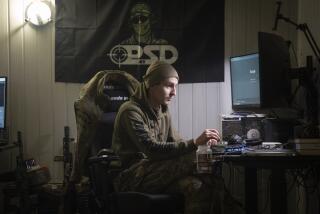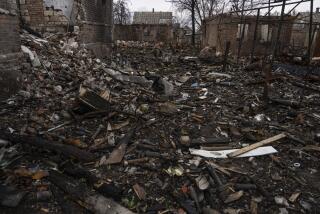Afghanistan Becomes War Laboratory for the Soviets
- Share via
PALM SPRINGS — After several weeks of continuous patrolling inside Afghanistan, Amin Wardak was leading his 18-strong band of moujahedeen guerrillas through Logar province toward Pakistan. As the two trucks entered a narrow valley, they suddenly came under heavy fire from silenced AK-47 automatic rifles. The night attack had been skillfully organized and, unable to see or hear their attackers, the guerrillas had no chance. All were killed. Wardak alone survived, because he had been scouting ahead on a motorbike.
A revolution in Soviet tactics in Afghanistan has made such ambushes common. Along with assassinations of guerrilla leaders, surprise night attacks on their bases and helicopter assaults on suspect villages, the Soviet army has taken the initiative in the war.
As one U.S. intelligence analyst puts it: “The temptation among Western commentators increasingly has been to surface the Vietnam analogue, with images of a giant superpower bogged down by primitive yet determined insurgents. This may be comforting but it is wide of the mark. Afghanistan, while costly, is viewed by the Soviet military as the first real operational laboratory since World War II.”
For military reasons alone, there is no reason to suppose that Soviet resolve in fighting the war in Afghanistan is weakening. But, when military successes are combined with a scorched earth policy and the comprehensive communist indoctrination of Afghan youth, the Soviets seem in a stronger position than ever before. Speculation that they are anxious for a face-saving agreement so they can withdraw from a too-costly war shows a basic misunderstanding of Moscow’s resolve and strategic considerations.
The Soviets originally invaded Afghanistan because they feared the rise of an independent regime in Kabul that might also be used as a base for Muslim extremists. Both worries remain and until a Soviet-approved regime is solidly established in Kabul, the Soviets will not leave. Meanwhile, an apparent willingness to discuss withdrawal is useful propaganda to undermine criticism of their occupation. War is expensive for the Soviets in cash and manpower but Moscow will never sanction a withdrawal that would leave Afghanistan open to the moujahedeen.
Certainly, there is little basis for optimism about an early Soviet pullout. As many as 1 million Afghans may have been killed in seven years of war, and another 3 to 5 million forced over the border into Pakistan as refugees. By contrast, the Soviets have 10,000 to 15,000 killed out of an occupying force of roughly 115,000. These losses are tolerable when put in the context of previous Soviet campaigns, where they have demonstrated a single-mindedness and ruthlessness unthinkable in the West. For example, in a 10-year campaign in Lithuania, ending in 1956, the Soviets had 80,000 army casualties and about 5,000 officials were killed while suppressing a CIA-supported rebellion of Lithuanian nationalists.
Western intelligence sources say the spearhead of the new tactics is Spetsnaz, Soviet Special Forces similar to the U.S. Green Berets, that are run by the GRU, Soviet military intelligence. Out of an estimated 25,000 Spetsnaz in the Soviet armed forces, over 4,000, in three brigades, are based in Afghanistan.
The Special Forces appeared in the country just before the Soviet invasion at the end of 1979. Commandos, mostly based at the Soviet Embassy in Kabul, were activated in advance and persuaded Afghan tanks crews to remove their batteries for “routine maintenance--so they were immobilized. The day after Christmas, Spetsnaz units arrived at Kabul airport and advanced on the capital using Afghan army vehicles, dressed in Afghan army uniforms. An attempt to poison Afghan President Hafizullah Amin by the KGB failed and, after a Spetsnaz assault on his palace, Amin was shot.
After the invasion, Soviet conventional military forces conducted the war and their tactics were largely responsible for early moujahedeen successes. Instead of fighting a counterinsurgency campaign, the Soviets used tanks and regular troops in cumbersome assaults against the mobile guerrillas, who used their knowledge of the difficult terrain to lure the Soviets into ambushes.
Now, the Soviets have adopted more aggressive tactics, moving the battles away from population centers and into the moujahedeen heartland. Using a devastating combination of nighttime Spetsnaz infiltration and fire-power support from attack helicopters, in 1986 the Soviets have taken the crucial Panjir Valley, which provided much of the guerrillas’ food, and have cut off many moujahedeen supply routes into Pakistan.
Little distinguishes Spetsnaz from the regular Soviet forces except the right to wear a prized blue-and-white-striped T-shirt, and paratroop wings on their uniforms. They are entitled to wear a blue beret, but this is not often seen in Afghanistan. The Spetsnaz appear to prefer a more raffish bush hat.
Their equipment is quite different from that of regular forces, however. In addition to silencers on their AK-47s, they use subsonic rounds that have an effective range of 50 meters, a spring-loaded knife that can fire a blade more than 15 feet, thermal-imaging for night vision, infrared detection devices and portable radios with high-speed transmission. In recent months, they have made increasing use of a new type of acoustic mine for ambushes. These mines, planted along known guerrilla supply routes, go off only when numerous vehicles or animals pass along the trail at the same time.
Spetsnaz troops have infiltrated guerrilla groups dressed as moujahedeen and they’re believed to have carried out pursuit operations into Pakistan. They also specialize in night operations, both for reconnaissance and setting ambushes. At the war’s start, guerrillas could move at night with virtually complete freedom.
Even with these improvements, Soviet tactics for this classic counterinsurgency war differ sharply from those used by the West. There has been no attempt at a “hearts and minds” campaign aimed at winning over the local population. Instead, there has been extensive use of napalm and bombing, to eliminate villages and destroy crops, as well as a concerted terror campaign, to drive the moujahedeen support network out of Afghanistan.
The increased use of Spetsnaz in the war has led to greater Soviet successes. But the Special Forces are less well trained than their Western counterparts. For example, they are still deployed in groups of 50 or more, compared with Western Special Forces, who operate in units of as few as four. The Soviets are still honing techniques.
The withdrawal of six regiments of Soviet forces in November should be seen in the context of changed tactics. Far from being a conciliatory gesture by Soviet leader Mikhail S. Gorbachev, it was an opportunity to remove anti-aircraft and tank units that were a wasted asset in what has become a truly unconventional war.
While improving their military capability, the Soviets, at the same time, have taken more than 10,000 young people back to the Soviet Union for indoctrination. Moscow hopes that this combination will, over a long period, eliminate opposition and produce a population trained in the Soviet way of life.
This could be over-optimistic. Despite moujahedeen reversals, there is no sign of weakening, as evidenced by their refusal, last week, of a Soviet-inspired call for cease-fire. If U.S. and Arab support continues at current levels, they will have the money, food and arms to carry on. But in a war marked by brutality and military incompetence on both sides, a victor is unlikely. The best either can hope for is stalemate when--as the British have found in fighting the Irish Republican Army in Northern Ireland--violence is reduced to a level tolerable to both sides.
In the meantime, the Soviets are using the lessons learned in Afghanistan to devise new tactics for their forces in Europe. Over the past few months, North Atlantic Treaty Organization intelligence has watched new tactics and training methods in operation at the secret Spetsnaz base at Furstenberg, in East Germany. The lessons learned in Afghanistan are being put to use.
More to Read
Sign up for Essential California
The most important California stories and recommendations in your inbox every morning.
You may occasionally receive promotional content from the Los Angeles Times.










